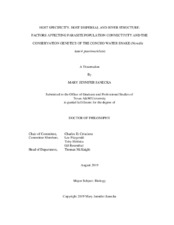| dc.contributor.advisor | Criscione , Charles D | |
| dc.creator | Janecka, Mary Jennifer | |
| dc.date.accessioned | 2019-11-25T21:16:43Z | |
| dc.date.available | 2021-08-01T07:33:09Z | |
| dc.date.created | 2019-08 | |
| dc.date.issued | 2019-07-19 | |
| dc.date.submitted | August 2019 | |
| dc.identifier.uri | https://hdl.handle.net/1969.1/186432 | |
| dc.description.abstract | Estimating gene flow is key to understanding local adaptation, population connectivity and the evolutionary trajectory of a species. For trematode parasites with complex life-cycles, definitive host specificity and dispersal combined with the physical features of landscapes can influence parasite gene flow. Likewise, understanding gene flow for species of conservation concern can help identify genetically isolated subpopulations. In this dissertation, I examine the influence of host specificity, host dispersal and the physical characteristics of the Concho and Colorado Rivers on the population structure of Renifer ancistrodontis and Renifer aniarum and the conservation genetics of one of their definitive hosts, Nerodia hateri paucimaculata. I determined that the host specific parasite, R. ancistrodontis exhibited similar levels of genetic diversity and population structure at the local level as the generalist parasite R. aniarum. The findings of this study do not support the predicted consequences of host specificity on parasite population structure. I then address the relative influences of host dispersal, unidirectional stream drift and dendritic ecological network on population connectivity of R. aniarum in the Colorado and Concho Rivers. I determined that host dispersal largely negates the influence of unidirectional stream drift.
Renifer aniarum also did not exhibit population structure concordant with the three reaches of the river but neither did it exhibit panmixia among locations. Rather, R. aniarum population structure was influenced by a combination of host dispersal and local transmission dynamics with a pattern of isolation by distance associated only with populations located on the distal branches of the upper reaches of the main-stem river. Finally, I determined that the Concho water snake showed significant population subdivision between the upper and lower Colorado River and O.H Ivie reservoir. Additional local population structure was detected between collection sites within the upper and lower Colorado River. Sibling groups were identified among neonate snakes collected during fall sampling seasons but removal of the siblings did not affect the patterns of population subdivision. Habitat modification and low water flows during periods of drought are likely to contribute to existing patterns of low population connectivity between the upper and lower Colorado River and O.H. Ivie Reservoir. | en |
| dc.format.mimetype | application/pdf | |
| dc.language.iso | en | |
| dc.subject | Parasite population structure | en |
| dc.subject | gene flow | en |
| dc.subject | conservation genetics | en |
| dc.subject | Nerodia | en |
| dc.subject | Renifer | en |
| dc.subject | Concho and Colorado Rivers | en |
| dc.title | Host Specificity, Host Dispersal, and River Structure: Factors Affecting Parasite Population Connectivity and the Conservation Genetics of the Concho Water Snake (Nerodia harteri paucimaculata) | en |
| dc.type | Thesis | en |
| thesis.degree.department | Biology | en |
| thesis.degree.discipline | Biology | en |
| thesis.degree.grantor | Texas A&M University | en |
| thesis.degree.name | Doctor of Philosophy | en |
| thesis.degree.level | Doctoral | en |
| dc.contributor.committeeMember | Fitzgerald, Lee | |
| dc.contributor.committeeMember | Hibbitts, Toby | |
| dc.contributor.committeeMember | Rosenthal, Gil | |
| dc.type.material | text | en |
| dc.date.updated | 2019-11-25T21:16:43Z | |
| local.embargo.terms | 2021-08-01 | |
| local.etdauthor.orcid | 0000-0001-6647-0898 | |


